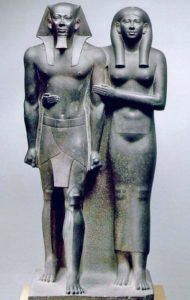The art produced by the ancient world is very significant in understanding the way society operated during those times. In class the three, civilizations that we studied were, Egypt, and Greece
The art produced by Egypt displayed that the qualities of power as well as the after life, were incredibly important to them. Egypt often had statues of and paintings of the beings that they viewed as powerful. the first being being the ruler of Egypt, the king, the pharaoh. often times statutes of the pharaohs were mad to honor and display the power of the ruler. the status would show the rulers decked out in all there royal attire, while sitting or standing upon their throne looking into the distance. Sometimes the statues or paintings didn’t only show the ruler ” ruling” per say, but often displayed actions of power. Other stone carvings produced by ancient Egypt show the Pharaoh conquering other human beings in war, displaying no threat to hinder his strength. the main reason why there was such an emphasis on the power held by the pharaoh was because, they rulers of Egypt were closely connected to the important after life. the afterlife in ancient Egypt was the notion that if any one person lived a balanced life and pleased the gods, they would be allowed to leave a joyful eternal life alongside the gods that have went on before them. Pharaohs were considered to be gods on earth, so striving to display the god’s powers one of many ways to please them.


The picture above depicts the journey of a scribe who in undergoing the process of the after life.He interacts with a serious of various gods (all in charge of various task) who judge whether or not he has lived a balanced life. The scribe passes all the test and is introduced to the ” god of all gods” if you will ( who may I point out was once a pharaoh on earth.) Its amazing how the Egyptians were able to interlock various beliefs and values into beautiful pieces of art.
The art that came from ancient Greece was similar in the fact that they exalted the power stemming from their culture. just like ancient Egypt The people of Greece displayed the power in their culture that they were most proud of through their art work. however unlike ancient Egypt the power that was displayed by ancient greece didn’t exalt gods per say, must exalted the power of the man, the human.

Humanism was the notion of celebrating the strengths snd qualities of that the human has displayed, rather than I’ve all the credit for advancement in society to gods. The base of the art in ancient Greece was humanism. The statues as the one displayed above showed how fearless and bold the humanism movement was in this society. here we see a young warrior/ athlete who is in shape in a lounging position. Instead of clothing this man, the sculptors decided to leave him with everything display. The reason for that being, other cultures were typically despised baring it all, and sometimes looked on nudity as shameful. the Ancient Greece culture however thought the exact opposite of nudity. The viewed it as a symbol of pride and strength. This explaining why their are multiple statues resembling the one above. In promoting true humanism in their society, ancient Greece discarded that their art would symbolize everything they believed in, unless ALL the qualities and features of them human were celebrated.

